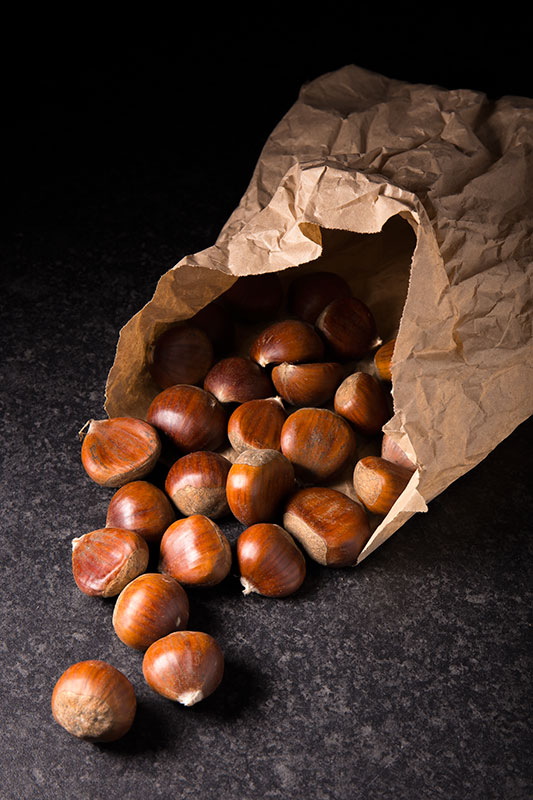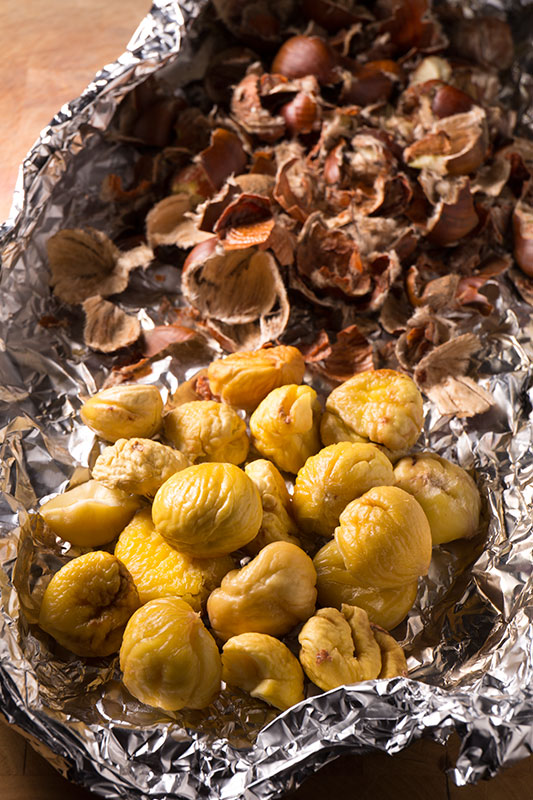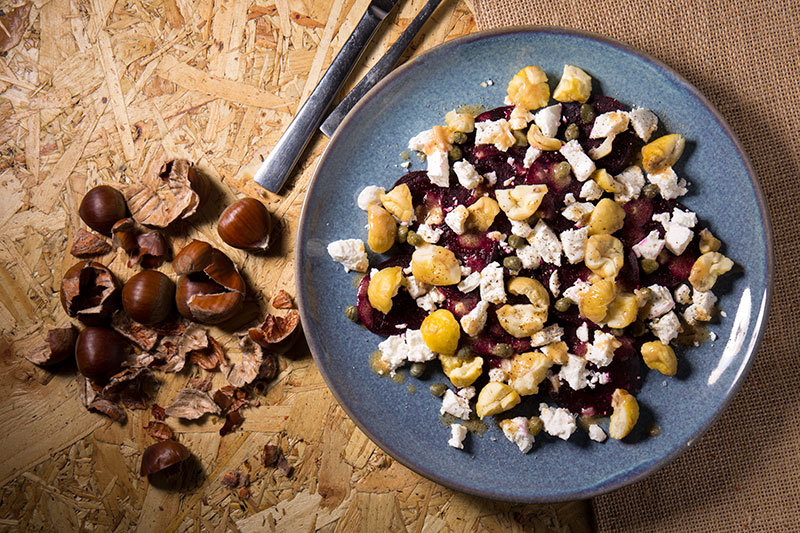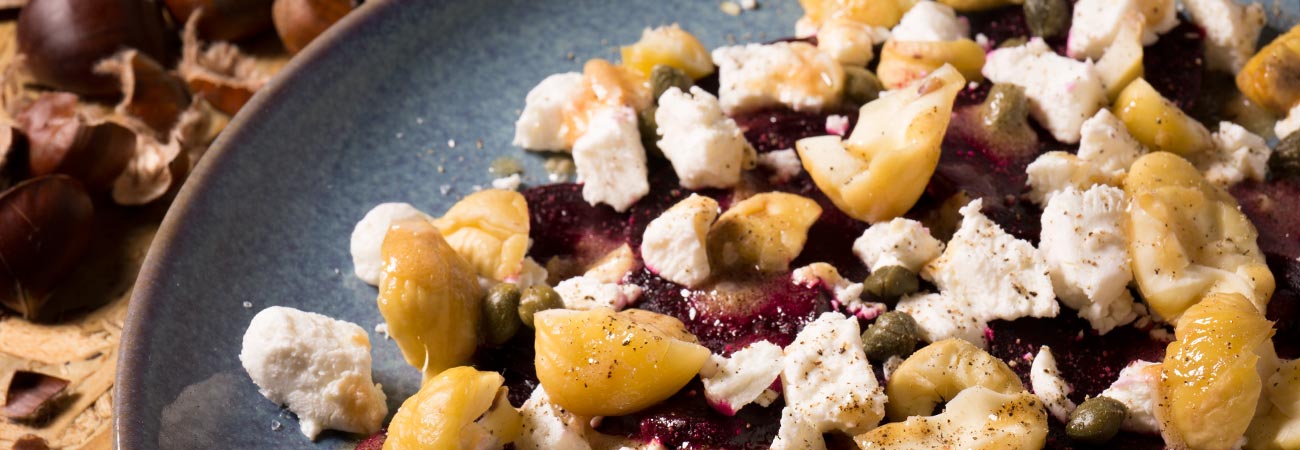Don’t make this recipe. Understand? Just don’t do it.

It’s self harm, it’s painful, agonising and frustrating. Don’t get me wrong, it tastes fantastic and I’ve been looking forward to remaking it for the blog so I could eat it again. It’s really easy to put together, only a few ingredients and if you use pre-cooked beetroot and chestnuts then it really is an honest 10 minute make.
But the real pain comes if you use fresh chestnuts, when it’s sweet chestnut season and the leaves are falling from the trees, creating burnt orange quilts under shaded woodland. Amongst the damp, soft ground you’ll find spiky balls that make hedgehogs seem like fluffy cuddle monsters. These contain those sweet, sweet chestnuts, the ones that when roasted over a hot fire taste of pure winter. Should you manage to hoodwink your way past the vicious thorny outers to the inner sanctum of the nut, you’ll find the fruit, the treasure, the glorious, errrr… tiny, barely edible chestnuts. I picked some up in the woods when out mushroom foraging a few weeks ago and my dad commented they would be tiny. He was right, they were minuscule, nothing like the large, bulbous chestnuts for sale at the corner shop.

Given the perils of foraging for your own (of course, a pair of gardening gloves and a bucket would solve the spikiness issue if you did find a hoard amongst the trees before the squirrels), it’s probably easier to buy some from the shop and roast them at home. Roasting chestnuts over a fire is such a comforting and homely image, who couldn’t resist? Well, I definitely couldn’t. I set out to find the best way to cook and peel them, starting with an open fire. It worked quite well, although I burnt a few of them and the inner shell was a real bastard to remove on some of them, so I thought there might be a better way. So I tried boiling them, but yet again, a few were easy to peel and others were like teasing chewing gum out of shag-pile carpet. I roasted them in the oven, both covered and uncovered and in the end I settled on roasting them, wrapped in foil, as this seemed to result in the highest percentage of easily peelable nuts.

Chestnuts have an outer shell, which goes tough when cooked and peels away fairly easily, leaving an inner husk-like skin. This is where the pain lies. It is thin, sharp and slides under your nails, leaving your fingertips bleeding. A percentage of the nuts might have even gone off, meaning this skin won’t want to be released from the inner nut at all. The internet is covered with ‘how to cook chestnuts’ guides demonstrating very British, restrained, linguistic moderation such as “these inners are trickier” or “the inner skin isn’t as easy to remove”. Do not trust them, they are lying. It’s not ‘trickier’, because that implies the outer is tricky, which it isn’t. Nor should ‘easy’ ever be used in reference to the more troublesome inner skins, because although some genuinely are easy and will flake off like a perfect croissant’s crunchy outer layer, others will have you crying, bleeding and wondering how one single nut can consume so much of your precious, valuable life.

In many ways, sweet chestnuts represent the embodiment of the buddhist idea that ‘life is suffering’, because in both life and chestnut preparation, there is pain and suffering and happiness and joy, all of which are impermanent. With the chestnuts, that pain and suffering is enduring when it happens, but it soon ends and gives way to the joy that is a warm beetroot and chestnut salad scattered with goat’s cheese, swiftly despatched on a cold autumnal day.
And when you finally recognise that suffering, like chestnuts, will always come and go, you can move on and live a happy, fulfilled life.

Autumnal warm beetroot and chestnut salad
By Gavin Wren
Serves 2 as a light main, 4 as a starter
Uses a baking tray and tin foil
PDF recipe card to download or print
Ingredients
250g whole sweet chestnuts or 200g pre-cooked sweet chestnuts, broken into chunks
500-600g Raw beetroot or 400g pre-cooked beetroot, sliced
125g soft goat’s cheese, crumbled
40 capers
For the dressing:
1 tablespoon red wine vinegar
3 tablespoons olive oil
1 teaspoon dijon mustard
1 small garlic clove, crushed
Directions
Pre heat your oven to gas mark 7, 425ºF, 218ºC, 198ºC fan. Trim the beetroot, leaving 1″ of stem, wash and place in a baking tin covered with foil. Put in the oven for 60 minutes. Meanwhile, cut a cross in each of the chestnuts, wrap them up into one big bundle with kitchen foil and place in the oven for 30 minutes. When the chestnuts are done, remove from the oven and peel them, being careful not to hurt yourself physically or mentally with the torment of doing this. When the beetroot is done, remove from the oven, uncover and leave to cool for 10 minutes. Peel them by sliding the skins off.
Mix together the dressing ingredients thoroughly until they become a smooth liquid. Slice the beetroot and layer on the plates, crumble the goat’s cheese over the top, scatter chestnuts around and dot with capers. Finally, spoon some dressing over the top and serve.
If you get everything ready to go, you can peel and slice the beetroot last, serving it while there’s still heat in it, meaning the goat’s cheese gently softens as you eat it.


